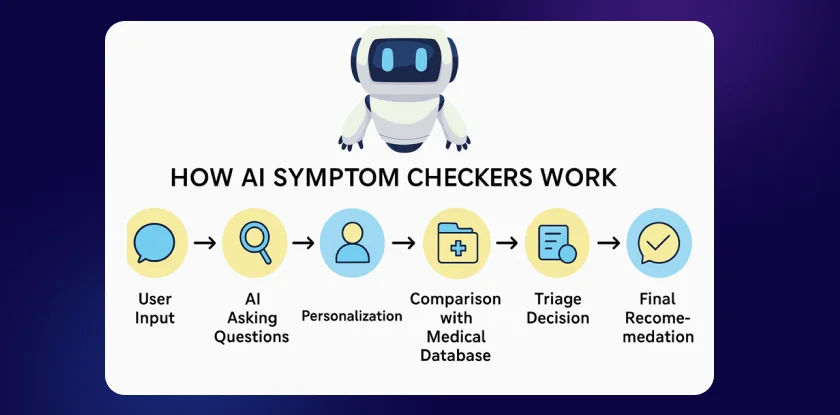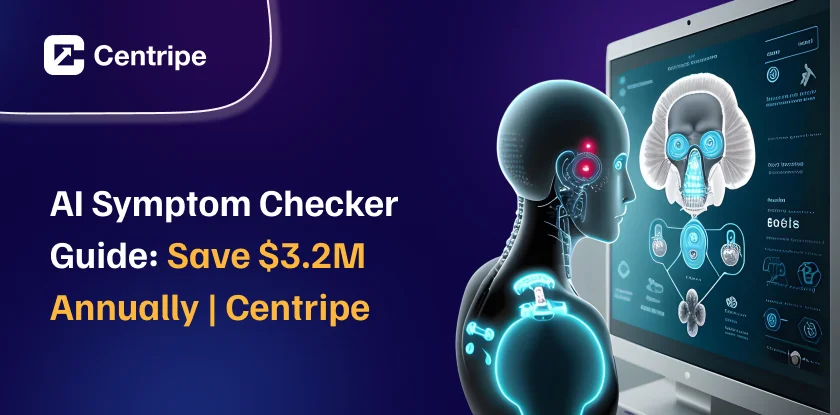Healthcare organisations save $3.2 million each year for every 100,000 patients by using one simple tool.
AI symptom checkers are not just tech gadgets. They are changing how 73.6% of patients approach healthcare. Their accuracy rates are reaching 70% and rising quickly.
Here’s something fascinating: Half of doctors report that their patients come in with health insights from AI. Think about that, 50% of patients are already using AI before they even see their doctor. Healthcare operations and patient care are changing right now.
These smart tools cut emergency department visits by 30%. They also achieve a 91.4% patient satisfaction rate.
If you work in healthcare, you should know how AI symptom checkers work and why they’re important.
What is an AI Symptom Checker?
An AI symptom checker is a clever digital health tool. It uses artificial intelligence to look at patient symptoms and provide care advice.
A sort of a smart health assistant. It can help you identify what’s wrong and suggest what to do next.
These systems differ from scary health websites that make people think they have rare diseases.
These medical AI chatbots use real algorithms trained on millions of cases. They deliver personalized, clinically-relevant guidance that actually makes sense.
The best part? Top AI symptom checkers are reaching 70% accuracy. That’s quite impressive for digital tools.
These platforms work like having a smart nurse available 24/7. You might need a free symptom checker for simple questions.
Or, you may want an advanced system to help “AI diagnose me” with complex symptoms. These tools are now key in modern healthcare.
How AI Symptom Checkers Work?

Here’s how these computer programs help you figure out what might be wrong when you feel sick
Step 1: Tell It How You Feel
Just describe your symptoms in normal, everyday words. You can say things like:
- “I feel dizzy”
- “I have a weird rash”
- “My stomach hurts”
This is a blessing, because you don’t need to know any medical terms. The AI will understand casual language.
Step 2: The Computer Asks Questions
Just like a doctor asks questions, the same thing goes for AI. It will ask you related questions to better know what is going on.
Example: If you say “my head hurts,” it might ask:
- “When did it start?”
- “Does it throb or feel sharp?”
Why this helps: These aren’t random questions. The computer knows which questions are most important for your specific problem.
Step 3: It Thinks About You Specifically
The system looks at things like:
- Your age
- Your past health problems
- Other risk factors
So why is it important?
A headache for different people might mean different things. For a young person, it could be due to stress, for an older person with high blood pressure, it might be more serious.
Step 4: It Compares Your Case
AI will check your symptoms with millions of other medical cases, it has learned from. It will even cross-check it with your previous medical history.
So, within fraction of seconds, it will find similar cases, tell you about the symptoms, suggest what can be done, etc.
Step 5: It Decides How Urgent This Is
The system tells you what to do next:
- Rest at home
- See a doctor this week
- Go to the hospital right now
It helps you know if something is truly an emergency or if you can wait.
Step 6: You Get Clear Advice
You receive easy-to-follow suggestions like:
- Take medicine (like ibuprofen)
- Apply ice
- Schedule a video call with a doctor
- Get immediate medical help
Extra Features
The best systems also offer:
- Support for many different languages
- Automatic summaries for doctors
- Multiple ways to check symptoms
The main goal: Give you helpful, personalized medical guidance quickly and in language you can easily understand.
Benefits: 5 Very Unique Advantages
1. Massive Cost Savings for Healthcare Organizations
AI chatbot helps healthcare organisations save $3.2 million each year for every 100,000 covered lives. Thirty percent of emergency department visits are unnecessary. These tools help redirect the right cases and save $150 to $300 for each visit that is diverted. For a health system seeing 100,000 annual ED visits, that’s $4.5-9 million in potential savings.
2. Dramatically Reduced Staff Workload
Organizations see 25-40% drops in nurse triage calls when using AI symptom checkers. Skilled nurses can focus on complex cases. They won’t need to answer basic questions. Call centers become more efficient, and staff stress goes down significantly
3. 24/7 Patient Access Without Extra Costs
Patients can check symptoms at 3 AM on a Sunday without calling anyone. Since 60% of health issues occur after hours, this is important for patient satisfaction. No more waiting until Monday morning to get basic health guidance.
4. Better Patient Education and Confidence
These Virtual Medical Assistant cut health-related anxiety by 40% compared to searching online. Patients get structured assessments instead of scary internet articles. 84.1% of users finally understand when they actually need to see a doctor, reducing unnecessary visits.
5. Improved Patient Flow and Wait Times
Pre-screening with AI reduces wait times at clinic by an average of 23%. Now, the patients arrive with preparation, appointments run smoother, and everyone is happy.
The automated intake summaries save time for both patients and medical staff.
Best AI Symptom Checker Tools
Here are the top AI symptom checker platforms based on accuracy and features:
Centripe- The Superior Assistant
Accuracy: Above 75%
Best for: All Healthcare organizations
Key strength: Quick Response and practical results
Price: Lower cost comparatively
Ada – The Accuracy Leader
- Accuracy: 70% (highest in the industry)
- Best For: Quality-focused healthcare organizations
- Key Strength: Superior diagnostic accuracy and detailed symptom analysis
- Price: Premium pricing for enterprise features
Babylon – The Integration Expert
- Accuracy: 65%
- Best For: Organizations with virtual-first strategies
- Key Strength: Seamless telemedicine integration and video consultations
- Price: Higher cost but includes comprehensive virtual care
Healthily – The Global Choice
- Accuracy: 60%
- Best For: International organizations serving diverse populations
- Key Strength: Multilingual support in 20+ languages
- Price: Moderate pricing with global capabilities
WebMD – The Familiar Name
- Accuracy: 55%
- Best For: Consumer engagement and brand recognition
- Key Strength: Widely recognized brand that patients trust
- Price: Lower cost option for basic symptom checking
Conclusion
AI symptom checkers are transforming healthcare right now, not in some distant future. About 73.6% of people now use digital symptom checkers. Some top platforms reach 70% accuracy. So, these healthcare chatbots are becoming essential.
There has been a significant drop in emergency visits, and high transparency. Patient satisfaction has increased immensely.
One can use these tools for easy, free symptom checks or even detailed analysis. This has become a game changer in healthcare, and with more features being added, it is set to challenge the traditional systems.
